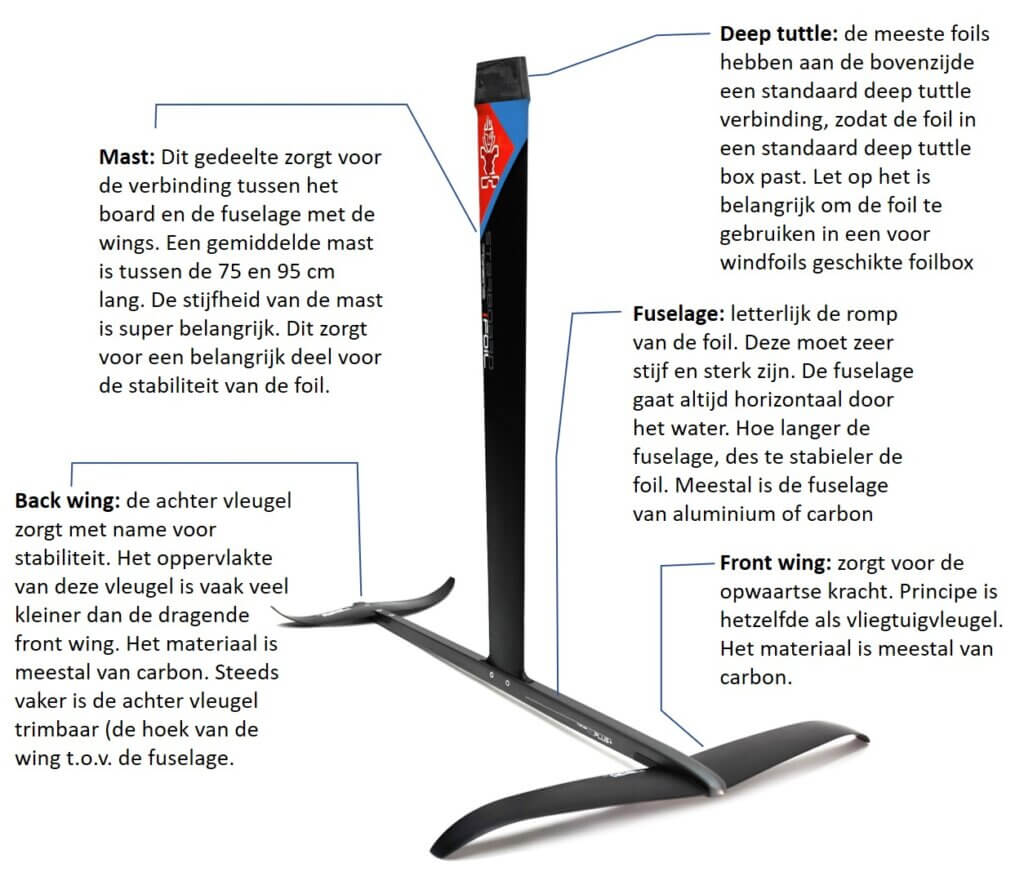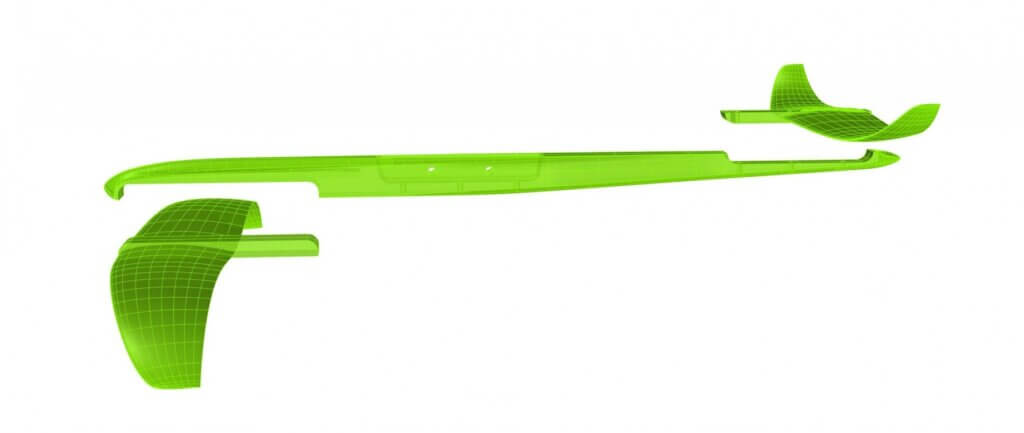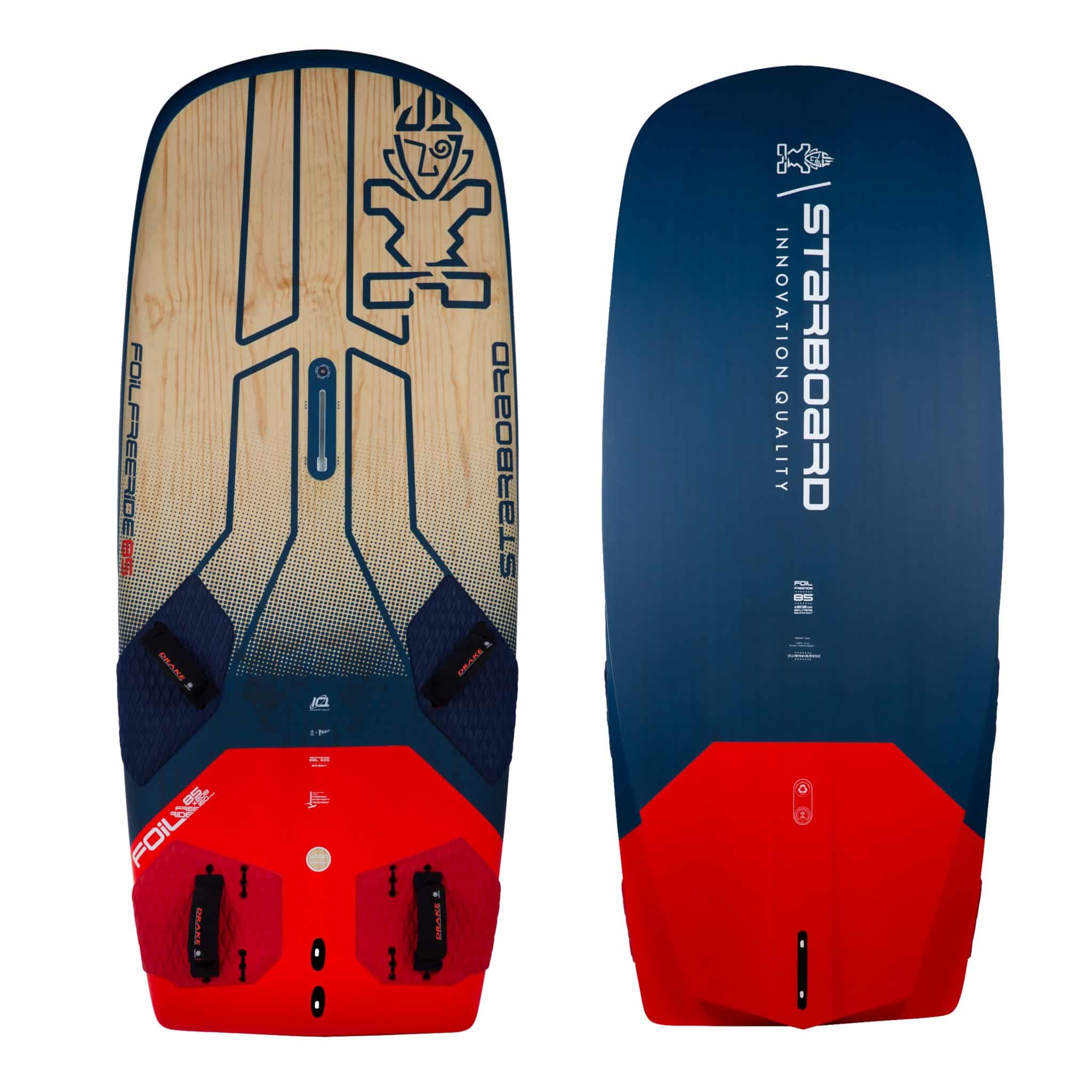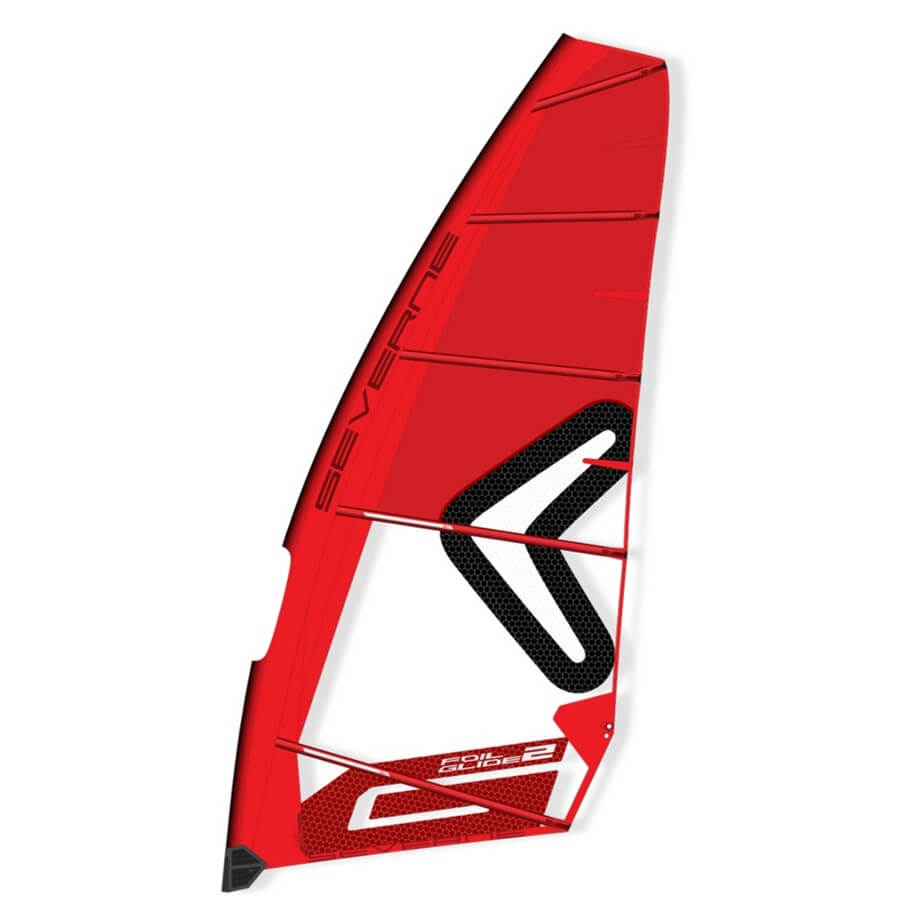Wind foil main part
An open door, maybe. Many surfers recognize the importance of a good fin under their board. The correct length, stiffness, profile and shape of the fin. In addition to the fin, the shape of the board and the so-called drag is also important.
In wind foiling, the ‘fin’ is a factor 10 more important than just windsurfing and the board again much less. In addition, the ‘fin’ of a wind foil consists of many more parts that each contribute to the ‘feeling of flying’. See the image next door, where the parts are beautifully named. Stiffness and a solid construction are the most important thing.
In addition to the wind foil itself, there is a development that the shapes of the boards will also look different. In the meantime, there are also special wind foil sails on the market that are specially developed to foil faster and in most cases are also lighter.

Mast
By far the most important part of the wind foil. This part is most like a traditional fin. Most wind foils fit into a regular deep tuttle fin box. The length of the mast varies between 70 and 115 cm. In addition to a good profile, the stiffness of the mast is super important. You can imagine that it is already quite wobbly on a board that flies about 90 cm above the water. A weak mast will reinforce this feeling. In addition, with more lateral pressure (upwind and with more wind) the mast will bend, so that the water flow flows in a less favorable way along the mast and wings.
Aluminium vs carbon
Most masts are made of carbon or aluminum. Carbon has the advantage that it is much stiffer than aluminium, but again more expensive than aluminium. The aluminium masts are already available (and also well stiff) up to a length of about 95 cm. In carbon there are even masts up to 115cm. The wind foils with carbon masts are more the high end oriented foils for match surfers
Fuselage
In other words, the rod the wings are connected (sometimes stuck and sometimes demonstrable) to the mast. This is often between 70 and 90 cm long. The longest are about 115 cm long. In main lines, the longer the fuselage is all the more stable (front-back and sailing course) the wind foil. However, a longer fuselage allows for more drag or braking action. In most cases, with a longer fuselage, the front wing sits further forward, causing the foil to rise faster. Nice with little wind, but less easy to control with more wind (also because of the greater upward force).
Aluminium vs carbon
Most manufacturers opt for an aluminum fuselage. Only brands opt for a carbon variant, however these wind foils are often very expensive (€ 3,000 or more!). The difference between aluminium and carbon for the fuselage seems small.
Wings
Each wing foil has 2 wings. A large front wing and a smaller back wing. The concept is similar to the wings of an aircraft. The profile has a flat side and a bulbous side. At the frontwing, the bulge is on the top for upward pressure. With the back wing, the emphasis of the bulge is right at the bottom. This just pulled the rear down, which makes the take-off easier. The back wing also provides stability and control while flying.
Larger surface is more lift
On average, it can be said that the larger the front swing, the greater the upward pressure. That is good for being able to fly quickly, but that upward pressure will work against more wind, because the front wing wants to go up even further. In addition, the resistance of a larger surface is also greater, which will lower the final speed of this wing foil.
Carbon vs epoxy
Most wind foils have wings that are carbon. The right profile and twist in the wings are important here. Cheaper foils have often made wings of epoxy (or similar material). This often makes the foil heavier and the profile of the wings thicker. Again, the carbon wings are more focused on speed and performance.
Vertical stabilizer
Some wind foils have a vertical ‘finnet’ at the back wing just like an airplane actually. This finnet provides extra price stability. This makes learning wind foiling easier. This stabilizer can therefore be found in most ‘entry level’ wind foils. In some cases, this fin can also be removed to reduce resistance. The most modern wind foils no longer have these vertical fins.

Impact of wing shapes explained
If you want to know more about the impact of wing design, read our extensive article where we explain all the basic aspects of wings.

Windfoil boards
Although you can wind up on an (old) formulaboard or wide slalom board, you can see that most brands have already introduced dedicated wind foilboards. In addition, more and more slalom boards are equipped with a so-called ‘foilready’ fin box.
So what’s different?
It’s nice to be on a wider board. A board of 80 – 95 cm wide is ideal. It is also nice to have a wide back. Many modern light weather slalom boards have a relatively narrow back. At the
new wind foil board you can see that the back is not much narrower than the widest point of the board. You stand much straighter on your board and lean more towards feeding, especially with a little more wind. As a result, the foot band positions come in a little more and the front foot strap position is a few centimetres more forward.
The most important thing is the reinforced fin box. Chances are very real that your vinbox in your slalom board is not resistant to the bigger forces that come up with it. Not only the (usual) sideways forces, but also the forward and also backward forces on the fin box. Especially in the period when you learn wind foils you regularly experience ‘nose drops’. This puts extra pressure on the fin box.
To prevent the nose from diving in the water (and you get a catapult with a nosedrop), the scoop of the specially developed boards is larger, precisely to prevent diving. Our experience is (and we have already sailed on many different boards) that diving into the water of the board is very bad in practice.
Need to purchase special board?
In any case, you need a board with a deep tuttle box and a strong vinbox is also absolutely necessary. Do you have an old board and do you want to take the risk? Then start on your old board.
Are you looking for a new slalom board? Then buy a so-called ‘wind foil ready’ board. With these boards, the vinboxes have already been strengthened and you can also just pop with a normal fin. Most brands now have several slalom and freeride boards in the range with ‘windfoil ready’ fin box.

Wind foil sails
The big advantage of wind foiling is that with a much smaller sail you can wind up very quickly. Our favourite size is between 6.5 m2 and 7.5 m2 and preferably a sail without cambers. Nice light and under 10 knots you can already fly. Flying with a 6.5 m2 or 5.5 m2 wave sail on a formula board is strangely enough a great combination. You’ll be amazed how early you can wind foil with such a small sail.
You’re overpowered with your sail on a wind foil much faster. The high cruising speed and the fact that you are much more upright compared to a normal slalom board are the causes. And believe us, being overpowered on a wind foil is really much less pleasant than on a slalom board. You’re almost 1 meter above the water and you remember it!
Nevertheless, there is also development towards special wind foil sails. Sailing that are built much lighter, less high end with less profile. The lower body is also less severely cut. This last because you’re sailing the rig more upright. And you do want it to connect nicely to your deck. The biggest advantages of these special sails are for the race oriented wind foiler.
What is our advice, buying special sails or not?
No no need. Just start with the sails you have. And preferably sailing without cambers or free race oriented sailing. Wave sails generally do particularly well, because they provide a lot of pressure and are light. If you are already well on the foil and you want to develop further, then purchasing good wind foil sails can help you a big step further.


